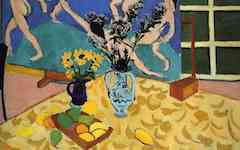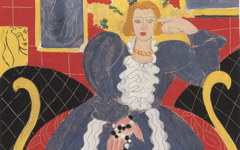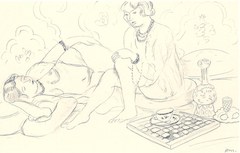Matisse’s The Window (1916)
Windows in art are important, full of potential self-referential symbolism. Not only do they often look like a painting on the wall but are framed as well. As transparent barriers or passage-ways between the interior of a room and its outside, they can also symbolize the artist's eye. In that event the room depicts the inside of the artist's head, exterior nature visible through its opening. Is that what's happening in Matisse's The Window (below)?
The first task when analyzing a work by Henri Matisse is to search for his initials. It seems quite unknown that paintings and drawings by him without an M are very rare indeed. Sometimes he even has H and M in the same picture right next to each other as in his masterpiece, The Red Studio (1911). They importantly emphasize the self-representational nature of the image. In this example, he has an M in the middle of the chair-back at left; repetitive M's in the radiator under the window and even more up and down the edges of the lace curtains. There are M's in the arms of the other chair too. I count at least 38 M's in this picture and every one is painted in black like his signature.
Click next thumbnail to continue

Top and bottom L: Detail and diagram of Matisse's The Window
Top and bottom R: Contemporary photograph of Matisse
Click image to enlarge.
Next look for circles or near-circles representing his "eyes" or "glasses" which were an important part of his public image. Once you find them, search for details like his beard, here in the radiator as shown in the diagram. The tip of his "nose" seems to be green, the color of creativity like the famous green stripe in his wife's portrait. The comical "nose" is not necessary, however, because the circles and radiator alone convey his "face". His pictured "mind", then, must be behind his eyes, the garden outside with a tree growing from his "pupil".
Click next thumbnail to continue

L: Matisse, Self-portrait (1916)
Top R: Matisse, Self-portrait (c.1920)
Bottom R: Matisse, Self-portrait (1920)
Click image to enlarge.
To demonstrate how important the glasses and beard were to Matisse's identity, here are three contemporaneous self-portraits. They also show how simply he would portray himself and even in caricature. (Note also the letter M's in three of his eyes and how they are formed into his hair at lower right too.)
Click next thumbnail to continue
Why does he depict his "mind" twice: inside the room and outside? All art seems to depict the artist's mind conceiving new art which must, in consequence, depict the artist's mind too. Thus Matisse's mind inside the room conceives The Window which, as a "painting", reflects his mind again, this time allegorically so-to-speak. In truth, both are allegories.
Click next thumbnail to continue
Rotate paintings too, even upside down. Doing so here reveals an old tradition: the artist as Christ. See how the window-frame forms a Cross between Matisse's "eyes". He was not really religious but used the Cross to convey the unity and purity of the creative mind and its process. Christ's Passion, furthermore, is often used in art as a metaphor for the creative struggle leading to Wisdom and Truth. As explained before, all major religions and many secular philosophies believe in the divinity or purity of the archetypal mind symbolized in Western culture by Christ.1
In conclusion, Matisse-lovers, keep an eye out for his initials, circles and signs of divinity. Find them and you will see and know what few ever have.
More Works by Matisse
Notes:
1. The Inner Tradition, too complex to explain here, continues uninterrupted from the beginning of history, and from probably before that too if Lewis-Williams' theory of neolithic art is correct.
Original Publication Date on EPPH: 05 Jan 2015. © Simon Abrahams. Articles on this site are the copyright of Simon Abrahams. To use copyrighted material in print or other media for purposes beyond 'fair use', you must obtain permission from the copyright owner. Websites may link to this page without permission (please do) but may not reproduce the material on their own site without crediting Simon Abrahams and EPPH.





